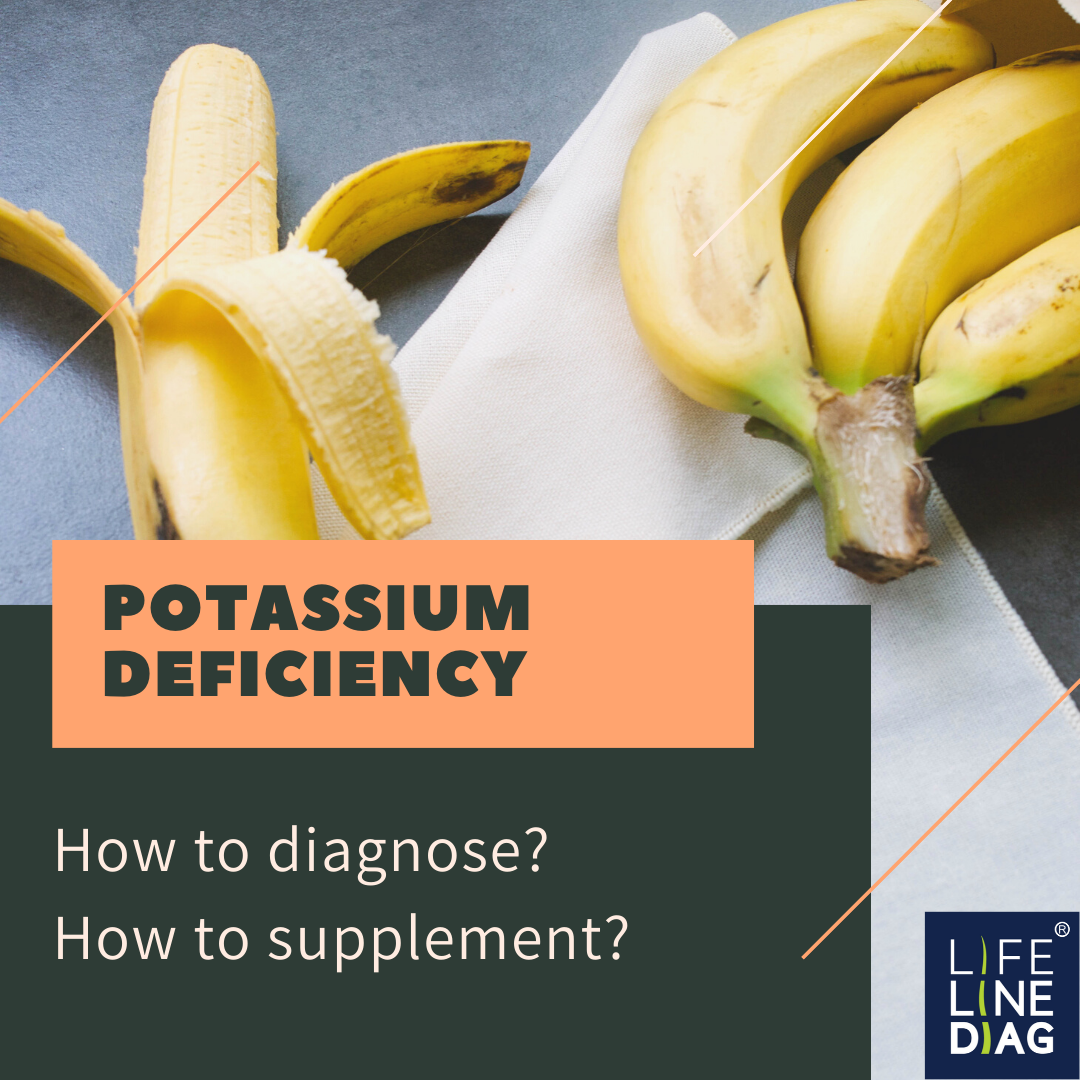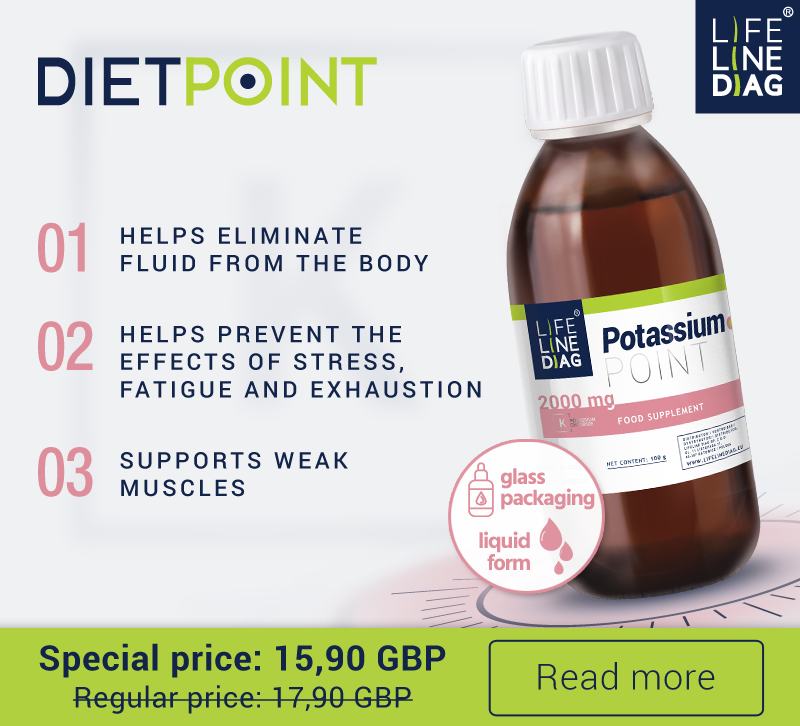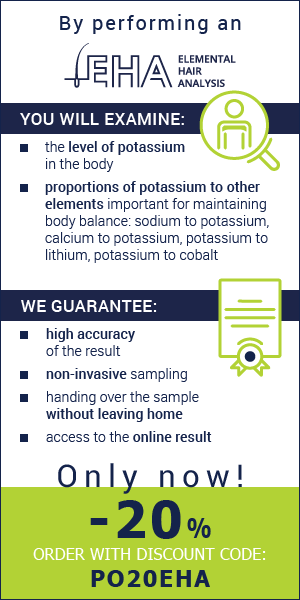 Hypokalaemia is the main indication for potassium supplementation. However, people with other ailments can also benefit from supplementing this element. Swollen legs, constant drowsiness, headaches, tremors in the calves or thighs, mood swings and irregular heartbeat can mean that you haven’t got enough potassium in your diet.
Hypokalaemia is the main indication for potassium supplementation. However, people with other ailments can also benefit from supplementing this element. Swollen legs, constant drowsiness, headaches, tremors in the calves or thighs, mood swings and irregular heartbeat can mean that you haven’t got enough potassium in your diet.
WHY DO WE NEED POTASSIUM?
Potassium is one of the most important elements in the body. As an electrolyte, it’s tasked with maintaining the correct voltage on cell membranes and transferring electrical impulses between cells. This means it controls the work of muscles, including the heart, and is responsible for each heartbeat. By participating in the process of building amino acids and proteins, it’s also responsible for the correct process of muscle building and for muscle mass, and due to magnesium antagonism, for proper muscle tone.
Potassium also helps to eliminate excess fluid from the body, which is particularly important when sodium intake is too high (as it is in modern society), since one of the things that excessive sodium causes are fluid retention and oedema of the limbs. As a sodium antagonist, potassium regulates the amount of water, reduces swelling and simultaneously reduces blood pressure. By controlling the water and acid-base balance, it helps maintain homeostasis in the entire body.
POTASSIUM ABSORPTION AND EXCRETION DISORDERS – HYPOKALAEMIA
Absorption of potassium occurs in the small intestine, and the main organs that maintain constant concentrations are the kidneys. Only 8% of potassium is excreted through the digestive tract. However, this value increases in patients with renal failure. Too much potassium eliminated from the body causes a deficiency, i.e. hypokalaemia.
Hypokalaemia is the main indication for potassium supplementation. However, people with other ailments can also benefit from supplementing this element. Swollen legs, constant drowsiness, headaches, tremors in the calves or thighs, mood swings and irregular heartbeat can mean that you haven’t got enough potassium in your diet.
The most common causes of hypokalaemia include:
- increased renal excretion of potassium: in some renal diseases, heart failure, liver cirrhosis, renovascular hypertension, Cushing’s disease and as a result of the use of diuretics;
- increased potassium excretion through the digestive system: as a result of acute infectious diarrhoea, diarrhoea caused by the use of laxatives, diarrhoea associated with entero-cutaneous fistula, or diarrhoea caused by cancer and chemotherapy;
- increased potassium excretion through the skin: as a result of severe and extensive burns or skin damage;
- insufficient potassium supply: anorexia, low-potassium diet, diseases associated with particular wasting away of the body, insufficient supply of potassium in conditions requiring increased dosage of this element;
- increased potassium inflow to cells: as a result of insulin therapy, alkalosis, or cell proliferation, for example, in leukemia.
Symptoms of hypokalaemia include:
- weak, flaccid muscles,
- arrhythmias and conduction disorders,
- a slight increase in blood pressure,
- hyperactivity.
Serious symptoms of potassium deficiency appear only when there’s a large drop in the concentration of this element, and disappear relatively quickly after the levels are regained. However, milder potassium deficiency can also cause unpleasant ailments such as general fatigue, water retention, swelling of the limbs, spontaneous tremors of the thighs or calves, and headaches.
The risk of severe potassium deficiency increases in the elderly, in whom the main factor contributing to this is insufficient potassium intake, increased potassium loss through the digestive tract, and frequent use of medications that increase its excretion.
DIET – WHICH PRODUCTS HAVE POTASSIUM?
According to Nutrition Standards for the Polish Population, the recommended daily potassium intake is a minimum of 4,700 mg, and for lactating women 5,100 mg. Potassium can be found in many foods. It’s in virtually all types of meat – white and red, as well as in fish and vegetables. Good sources include broccoli, spinach, legumes – peas and beans – as well as potatoes (mainly the skin), tomatoes and pumpkin. Potassium can also be found in fruits such as bananas, kiwi, citrus, plums and apricots (higher in dried apricots). Milk, yoghurt and nuts also have potassium.
Unfortunately, it’s well known that nutrients, for various reasons (including due to illness), may not be fully absorbed from food, or the food itself is so poor in nutrients that it doesn’t meet the need. Building an optimal diet is not easy. For example, the average potassium content in the diet of hypertensive patients provides only approximately 70% of the RDI, which is caused by insufficient consumption of vegetables and fruits. Therefore, if potassium supply needs to be increased, supplementation should be considered.
POTASSIUM LEVEL DIAGNOSTICS
The first thing to do is determine the potassium levels in your body. Information on whether your system has a deficiency, an excess or the potassium level is normal can be obtained from the results of elemental hair analysis (EHA). The results reflect the concentration of potassium in the body, and the levels of the remaining 28 elements are a hint as to the reason for possible potassium deficiency and invaluable help in choosing the right treatment and supplementation. Results that show a severe potassium deficiency require further targeted diagnosis.
POTASSIUM SUPPLEMENTATION
Potassium supplementation is necessary in hypokalaemia. It should also be considered in people who are at risk of potassium deficiency (without hypokalaemia). The risk group includes the elderly and people with hypertension, cardiac arrhythmias, after stroke, with nephrolithiasis or osteoporosis.
There are research results that show the benefits of increased potassium intake in adults with hypertension. The studies demonstrated a reduction in systolic and diastolic blood pressure, as well as a lower risk of stroke by an average of 24%. At the same time, no adverse effects of increased potassium intake on renal function were observed.
In animal studies, a reduction in the risk of thrombosis due to increased potassium supply, and a decrease in urinary calcium excretion were also observed. It has also been shown that patients who excrete more potassium have a lower risk of enlargement of urinary stones. A reduction in calcium excretion in people with high potassium intake is also a reason why the risk of developing osteoporosis is reduced.
Determining the type of potassium supplementation requires an individual approach that takes into account the condition of the body’s organs responsible for regulating this element. Currently, the most commonly used forms of potassium (potassium chloride) are tablets or capsules. However, the liquid form of the supplement is best absorbed by the body. When choosing a product, take note of the potassium content.
Factors that require special caution during potassium supplementation include, but are not limited to, long-term bedridden illness, low fluid intake, difficulty swallowing, gastroparesis, and medication. Potassium products should be taken after a meal with at least 100 ml of water at room temperature, and you should remain standing or sitting for about 10 minutes.
Lifeline Diag















